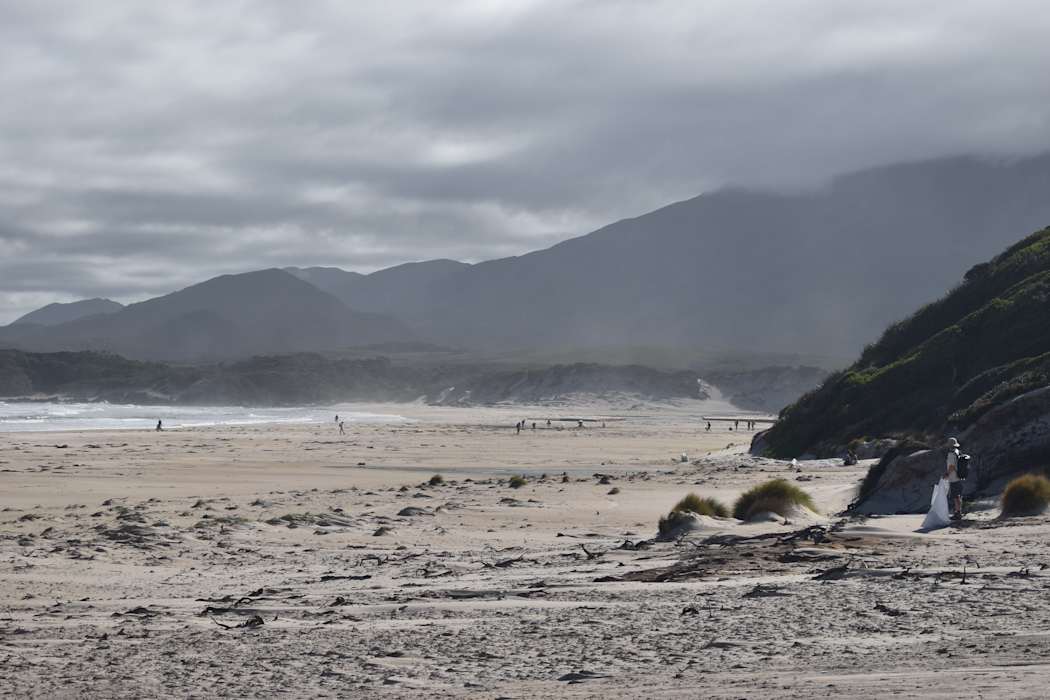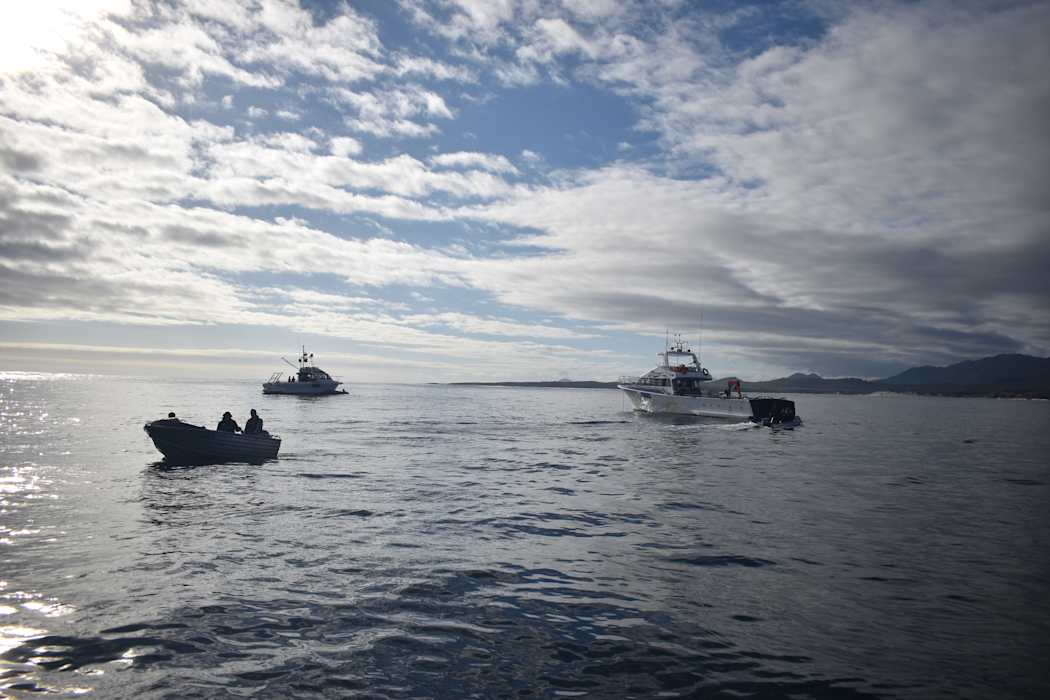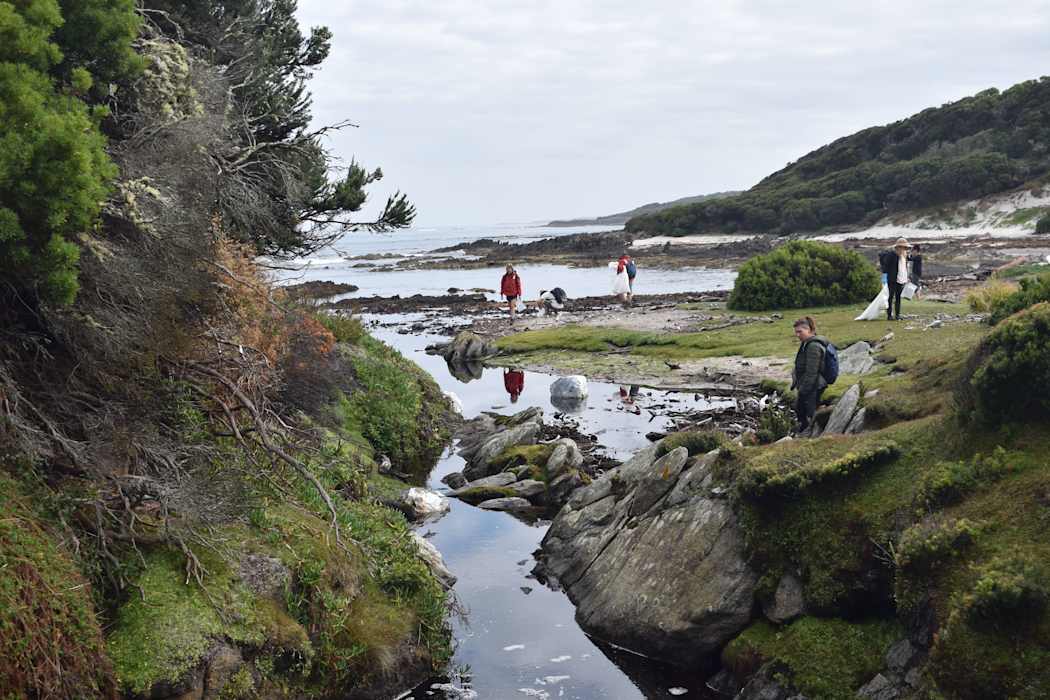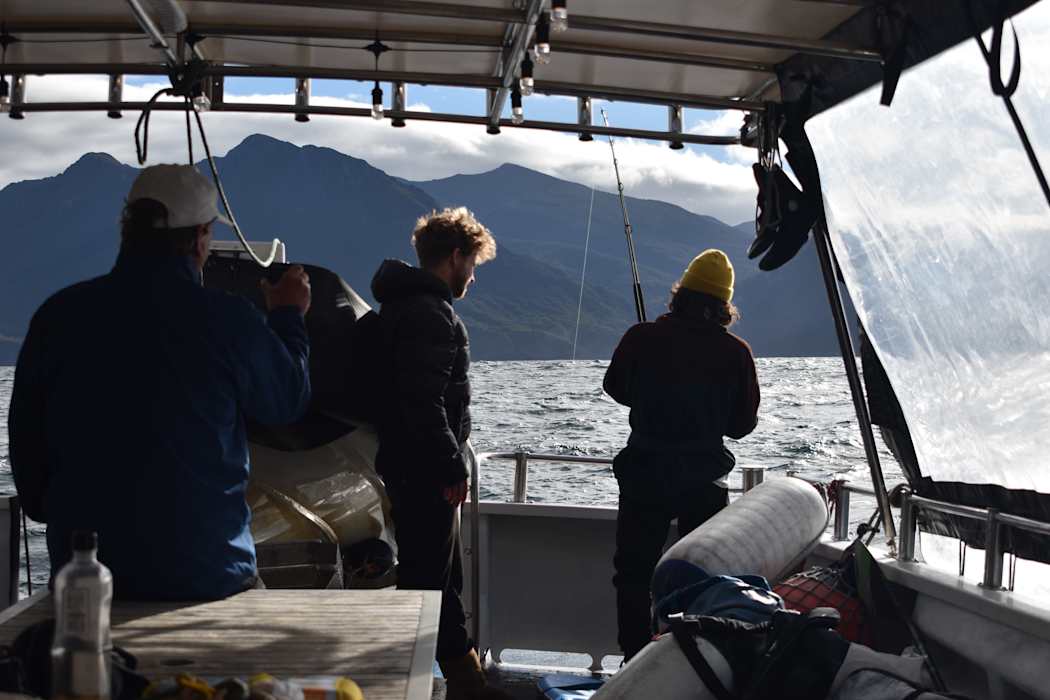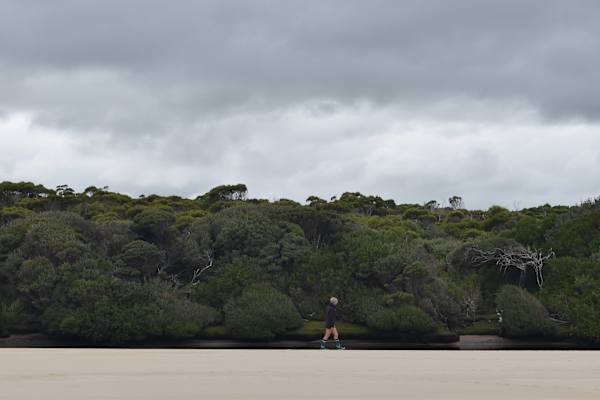“In 1830, the self-proclaimed Conciliator [George Augustus Robinson] … pursued Towterer’s community across their homelands, hoping to persuade them to leave their country, with all the resources and inspiration it gave them, and live elsewhere. Robinson believed that this would bring about the end of the Black War.
“This had happened at almost exactly the same time of year that we sailed in, as summer cedes to autumn. The last pigface flowers were shrivelling; spinebills chased each other through the scrub; jackjumpers were rebuilding nests, decorating them with millipede shells and pinkberries. These are the details I needed to see for myself. It’s as though ecology must fill the history for it to make sense. The story of Tasmania’s frontier conflict is, after all, a story about habitat, about home.”
writer and photographer BERT SPINKS
Over Easter 2024, I joined a marine debris clean-up project, part of a crew of 27 who set out for the remote south-west coast to collect rubbish. The unappetising scene introduced above was not atypical. There was a lot of kneeling over, peering intently, scrutinising minutiae and, later, sorting it.
We had set out by boat from Southport on one of those autumn days that stuns you silly. It was a bit wobbly rounding South East Cape, but on the back deck of our boat, looking at the crumbling southern extremity of our island, I found myself grinning foolishly. The jumble of coastal bluffs and cliffs, and the mountain ranges that rose from the hinterland, looked immense and impressive.
When we got to the west coast, we were dropped off on the first of half-a-dozen beaches that we’d clean. It wasn’t all hard labour, I have to admit: there were opportunities to surf, swim, dive, whittle driftwood and even bushwalk. When the sun was out, and we were on gorgeous beaches looking out on the Southern Ocean, we might take a leisurely lunch-break. Mostly we had ideal weather, although sometimes getting the dinghy to shore was treacherous business – a few of us ended up, unintentionally, in the drink.
Four fishing boats were donated for the 10-day trip. These were our home base, and also the headquarters for our nightly task of sorting and counting the rubbish we’d found. For this procedure, tarpaulins would be laid out on the deck and our collection would be dumped onto them. We’d then start fossicking through it, trying to put each piece into a category, finishing up with a daily tally. My first impression was that it was chaos, but quickly enough I got the hang of it.
You may wonder what kinds of rubbish get washed up onto the beaches of the south-west coast. I wish I could tell you that I found something of great worth or intrigue, but the most interesting object I picked up was a plastic oil or detergent bottle with Chinese figures on it – I thought it might have come from the 1990s, because it had a cool vintage design. (It now strikes me that we should host a south-west clean-up version of Antiques Roadshow.) Other people found covid tests, printer cartridges, toy figurines. There was nothing remotely of value.
I was assured that in other years there had been cooler stuff picked up, but the unglamorous truth is that most of what we collected was microplastics. These were tiny shards of anonymous plastic, or minute strands of synthetic rope, or those fiddly bits off the fertiliser bag. It was sometimes meditative to follow the tide-line, trying to distinguish rubbish from organic marine debris – you might be surprised how much natural beach bric-a-brac can be mistaken for garbage – but it also tested our patience.
We collected a lot of colourful nurdles. You may not know what nurdles are; I only had a vague idea myself, but after I picked up innumerable quantities of them, I decided to do some research. Nurdles are raw plastic pieces, often used as components for the fabrication of larger plastic objects – “pre-production plastic pellets” is the pleasing definition I found. Each nurdle is the size of a lentil. More than 200,000 tonnes of nurdles end up in the ocean each year. If you look up nurdles, you will see a photograph of a fish with a gobful of them. I think we should know about nurdles.
. . .
It is a curious crew of people who head to the south-west for 10 days to mostly pick up microplastics. Partly this is because the project co-ordinator, Matty Dell, is himself a man of eccentric and wide-ranging interests. From the outside, it’s hard to tell if there’s any real criteria for how a person gets accepted as a volunteer. I’m told there’s a long waiting list, but I also get the feeling that Delly deliberately curates an eclectic group, almost as a social experiment. The rubbish clean-up has been going for 25 years, and it has developed an idiosyncratic culture. It was fun to join in that vibe.
On most nights, the four boats were sheltered in the same bays, anchored apart – we’d get run between boats by dinghy, as necessary – but there were a few occasions, particularly in Port Davey, in which the boats would be lashed together. Then, we could have shared meals, as well as a few drinks. The band would play – did I mention there was a band? A handful of musos was included in the crew. They set up instruments and amps, and gently crooned their soothing tunes to us. One night, a small disco ball was lifted by hydraulic crane over the deck of a boat.
I decided to make a podcast about the trip – an additional contribution, I hoped, to the clean-up project. But pondering the stories of south-west Tasmania, and looking at them through the peculiar lens of a rubbish clean-up, sent me occasionally spiralling into less happy streams of thought. One evening when we were rafted up, and eating on the deck of a boat, I elbowed someone’s plate into the water. It was pretty depressing to think that after a day of picking individual bits of rubbish off the beach, I could so easily have dumped a similar mass of plastic into the water.
It was interesting to have this kind of human company in such a place. Generally, I like to be alone in the bush; sometimes it’s nice to have one companion, but I rarely enjoy being in a group. (Maybe I’m burnt by so many years working as a bushwalking guide.) Here, I had signed up to participating in a team, however, and I tried to keep my solitary habits to myself. It helped that the people around me were so varied, that music was good, as was the beer. The disco ball was a lovely touch.
I should admit that I signed up for this project mostly to return to the south-west. On our list of possible clean-up sites were beaches that weren’t easily accessed by bushwalkers. Of course I was also keen to do a good deed – I’m not completely selfish – but the south-west is a special place, unique on Earth, and I’m obsessed with getting to know these landscapes, trying to entwine my life with the Tasmanian bush.
The last time I was in the south-west, camped at the Crossing River for the better part of a week, I had carried a copy of George Augustus Robinson’s journals with me. Those who know about this book may be impressed – it probably weighs more than my tent and Trangia combined. I was aware that an important chapter of colonial history had taken place in south-west Tasmania. Reading an account, in situ, was a powerful experience.
As many of you will know, George Robinson spent a decent chunk of the 1830s in the bush, interacting with the clans of the first Tasmanians. His idea was to resolve the Black War and bring about reconciliation between Aboriginal and colonist communities. This failed. I’ll avoid any real interpretations of what Robinson’s so-called Friendly Mission meant, but I do believe that this chapter of our history is of the utmost significance. The journals are also an incredible work of literature. In some ways, I think of Robinson’s journals as a mythic text, like the Iliad or the Mahabharata. It’s not that there’s a whole lot in his writing to which we might aspire, or that I reckon Robinson is some kind of saint. But these are the foundational stories of modern Tasmanian life, the epic of how the violence of British settlement disrupted the traditions and cultures of the first Tasmanians, and how Aboriginal people did everything they could to endure that.
And as I say, a memorable chapter occurred in the south-west. The coastline on which we worked was the country of the Port Davey people, known in Robinson’s text as the Toogee, their leader a powerhouse by the name of Towterer. In 1830, the self-proclaimed Conciliator – with his acquaintances from Bruny Islanders, Aboriginal survivors who had formed a shaky alliance with Robinson – pursued Towterer’s community across their homelands, hoping to persuade them to leave their country, with all the resources and inspiration it gave them, and live elsewhere. Robinson believed that this would bring about the end of the Black War.
This had happened at almost exactly the same time of year that we sailed in, as summer cedes to autumn. The last pigface flowers were shrivelling; spinebills chased each other through the scrub; jackjumpers were rebuilding nests, decorating them with millipede shells and pinkberries. These are the details I needed to see for myself. It’s as though ecology must fill the history for it to make sense. The story of Tasmania’s frontier conflict is, after all, a story about habitat, about home.
. . .
It is normal, I think, to feel gutted at the sight of plastic fragments strewn across the beautiful shell-bejewelled hillock of an old summer campsite. Still, I made sure that the overwhelming feeling I had on this south-west trip was one of gratitude. Sometimes you realise, as it’s happening, that you’re having a special experience in life. That was certainly the case on the autumn days of the beach clean-up.
It is hard to know exactly what difference we made with our 10 days of hard work. This was a conversation I had several times, with others who were perhaps as reflective and circumspect – mopey – as me. It’s definitely true that we made these beautiful remote beaches visibly cleaner. In the end we picked up more than 55,000 pieces of rubbish, which felt like quite a decent effort. But as the rubbish later got dumped at the Dover tip (who didn’t waive fees for us) we perhaps have merely relocated the problem.
As far as I can tell, there are few answers about what we’re supposed to do with our waste. It is extremely easy to become cynical, and I see it happen, even with people who are younger than me – they have followed the news and know what happens to their recycling, and feel fatalistic about that, as with many other subjects to do with the future of our planet.
But as I skirted the edge of a midden to pull out the bits of plastic, I considered that there may be no more effective means of building a practical form of ethics than picking up rubbish. You get awfully bloody close to an ecosystem when you kneel upon it for hours at a time, moving laboriously along beaches and in the bush with your eyes focused. I cherished the chance to do this in south-west Tasmania, an opportunity that doesn’t often come along.
What is necessary, I suspect, is for all of us to take responsibility for the places in which we live and travel. We must cultivate ecological awareness and a sense of respect for the habitats of others. For some folk, this is called “care for country”. Perhaps as this idea grows, we’ll find a way to create less waste. Even if it doesn’t, I’d still recommend it as the best and most beautiful approach to life.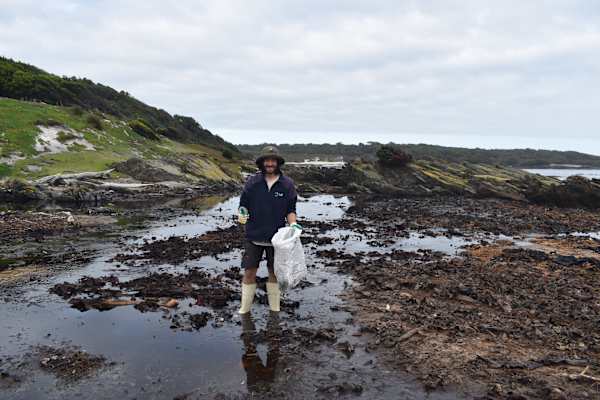
Bert Spinks is a writer, poet, storyteller and bushwalking guide from Tasmania. For many years he has performed and published Tasmanian stories. Most of the time, he's based in an old train carriage in the bush. He has a podcast, In a Train Carriage, Going Nowhere (soundcloud.com/storytellerspinks), and shares writing and photography at the blog Letters from a Storyteller (storytellerspinks.substack.com).


